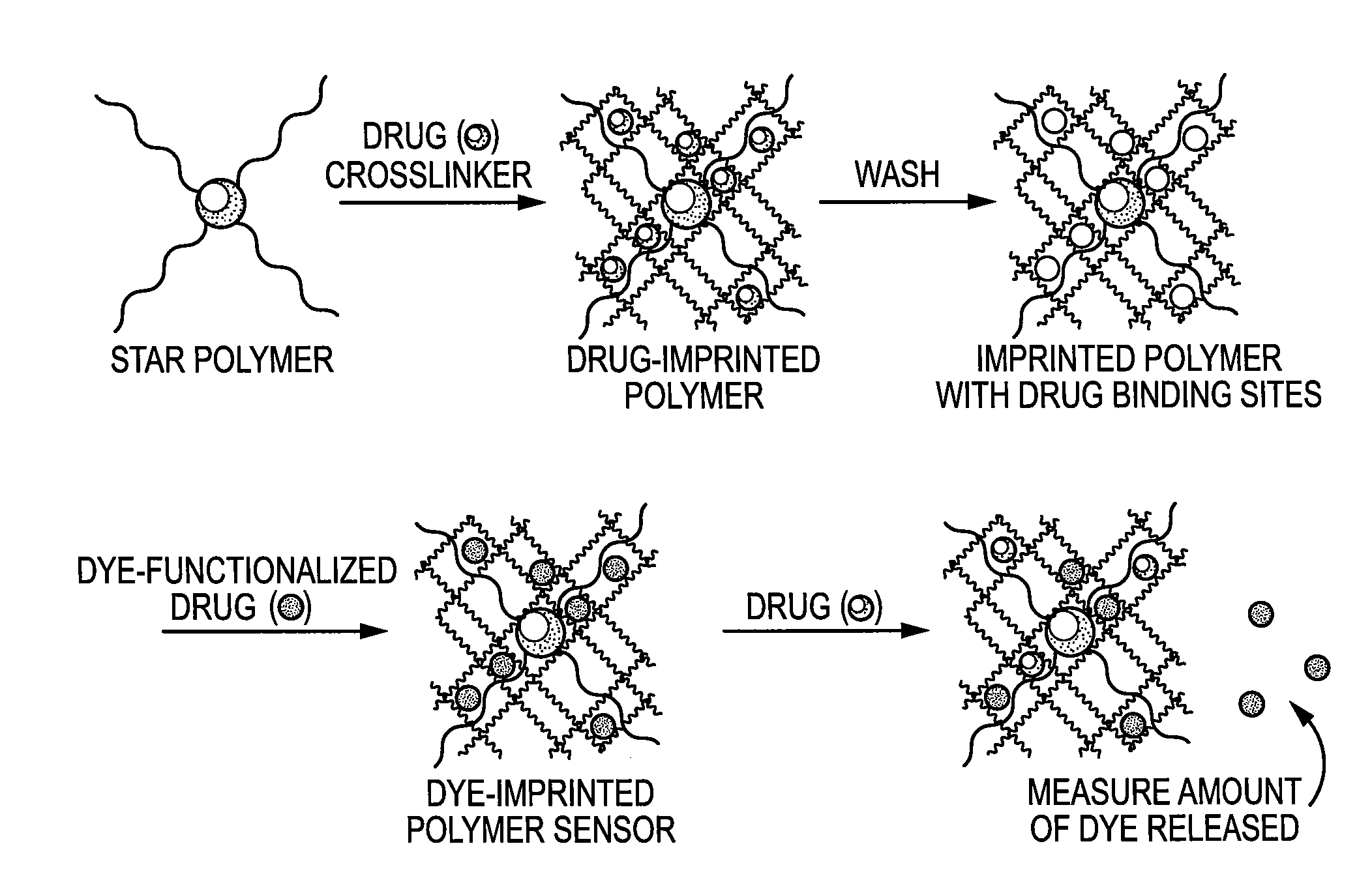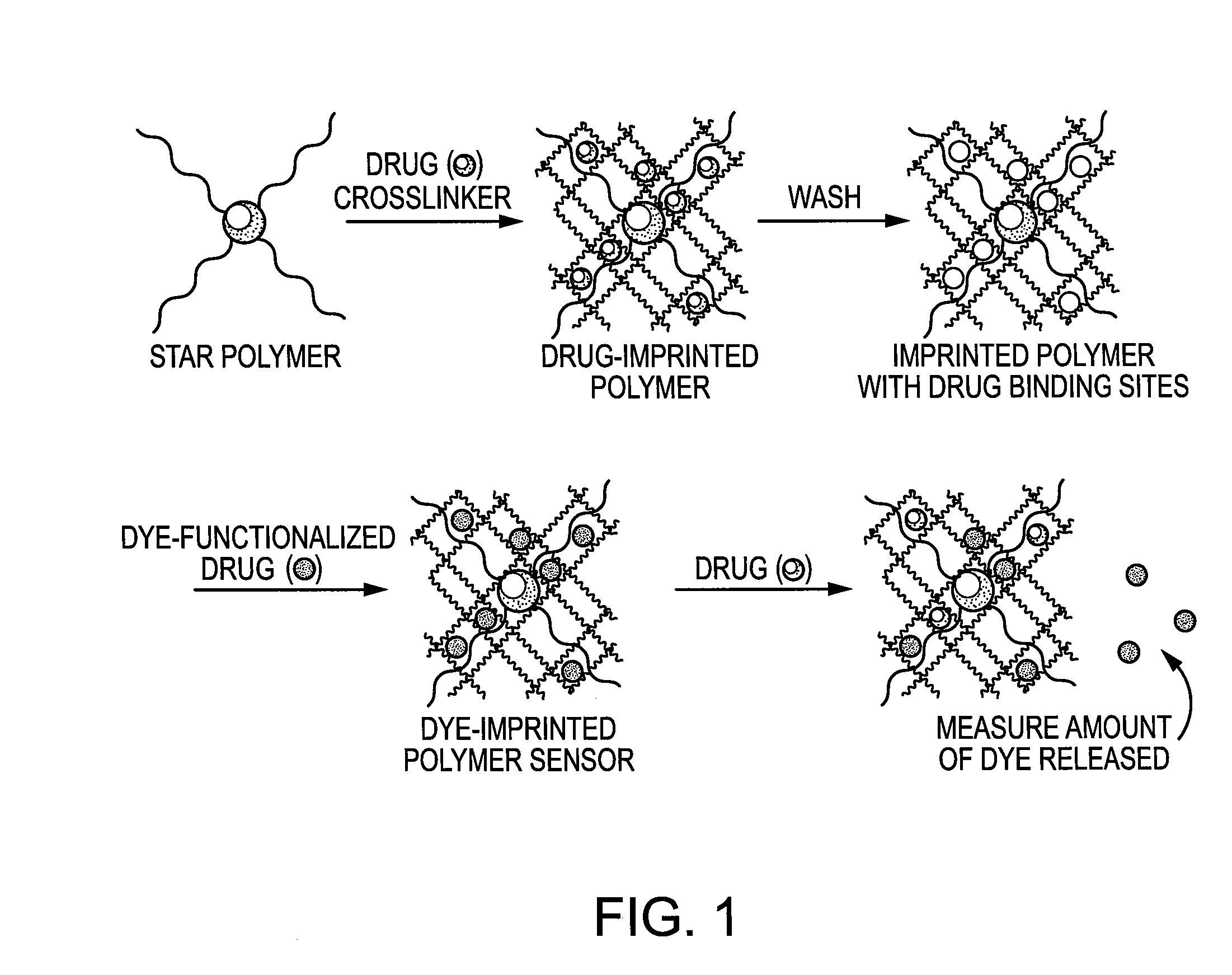Molecularly Imprinted Polymer Sensor Device
a sensor device and imprint technology, applied in the direction of instruments, food testing, analysis using chemical indicators, etc., can solve the problems of increasing the risk of drinking beverages in social settings such as bars and restaurants, unchecked drug rape, and unwillingness to come forward, so as to achieve high selectivity, convenient and expeditious
- Summary
- Abstract
- Description
- Claims
- Application Information
AI Technical Summary
Benefits of technology
Problems solved by technology
Method used
Image
Examples
example 1
Step I: Preparation of 4-Nitrosodimethylaniline Hydrochloride
[0046]4-Nitrosodimethylaniline (4.0 g) was treated with 20 mL of 6M HCl solution. The green solid quickly changed to a lighter yellow-green color. After stirring for a few minutes, the solid clumps were broken up with a glass rod, and the yellow-green solid was filtered off. The product was washed with 6M HCl solution followed by methanol. The solid was dried under vacuum to give the hydrochloride salt (3.99 g, 80%).
Step II: Preparation of 2-amino-5-dimethylaniline Thiosulfuric Acid
[0047]4-Nitrosodimethylaniline hydrochloride (4.0 g, 21.4 mmol) of step I was added to a solution of glacial acetic acid (8 mL) in water (24 mL). The suspension was cooled to 0° C. in an ice bath and a solution of sodium thiosulfate pentahydrate (23.5 g, 94.1 mmol) in water (24 mL) was slowly added over 15 minutes. The solution darkened considerably during the addition. The reaction was stirred at 0° C. for four hours and then stirred at room te...
example 2
Step I: Preparation of Ethyl 5-(N-methylanilato)valerate
[0048]A round-bottom flask was charged with N-methylaniline (2.60 mL, 23.9 mmol) and acetonitrile (40 mL). A syringe was used to add ethyl 5-bromovalerate (4.0 mL, 25.1 mmol) and 2,6-lutidine (2.91 mL, 25.1 mmol). The reaction was heated at reflux for 40 hours, at which point the solution was a pale green-brown color. Acetonitrile was removed under vacuum and residues were dissolved in ether and water. The organic phase was collected and washed with water. After drying over magnesium sulfate and filtering, the solvent was removed to give a brown liquid. The crude product was purified by column chromatography (10% ethyl acetate / hexanes) and was collected as a pale yellow liquid (4.96 g, 88%).
Step II: Preparation of 5-(N-methylanilato)valeric Acid Hydrochloride
[0049]Ethyl 5-(N-methylanilato)valerate (2.0 g, 8.50 mmol) of step I was dissolved in methanol (5 mL). A solution of sodium hydroxide (340 mg, 8.50 mmol) in water (5 mL) wa...
example 3
Step I: Preparation of Carboxylic Acid-Functionalized Methylene Blue
[0050]5-(N-methylanilato)valeric acid hydrochloride (1.66 g, 6.81 mmol) of Example 2 and 2-amino-5-dimethylaniline thiosulfuric acid (1.61 g, 6.47 mmol) of Example 1 were combined in a round-bottom flask with 1M HCl solution (6 mL) and water (84 mL). The suspension was cooled to 0° C. in an ice bath and a solution of potassium dichromate (1.27 g, 4.32 mmol) dissolved in water (12 mL) was added dropwise by pipette over 15 minutes. The dark green reaction was stirred at 0° C. for one hour. Glacial acetic acid (180 mg) was added and the reaction was stirred for and additional hour at room temperature. The solution was filtered to give a purple-blue solid, which was washed with water. The solid was then dissolved in acetonitrile (80 mL) to give a purple-black suspension. Manganese(IV) oxide (1.58 g, 18.2 mmol) and a catalytic amount of copper(II) sulfate were added and the reaction was heated at reflux for 90 minutes. T...
PUM
| Property | Measurement | Unit |
|---|---|---|
| Molecular structure | aaaaa | aaaaa |
| Colorimetric evaluation | aaaaa | aaaaa |
Abstract
Description
Claims
Application Information
 Login to View More
Login to View More - R&D
- Intellectual Property
- Life Sciences
- Materials
- Tech Scout
- Unparalleled Data Quality
- Higher Quality Content
- 60% Fewer Hallucinations
Browse by: Latest US Patents, China's latest patents, Technical Efficacy Thesaurus, Application Domain, Technology Topic, Popular Technical Reports.
© 2025 PatSnap. All rights reserved.Legal|Privacy policy|Modern Slavery Act Transparency Statement|Sitemap|About US| Contact US: help@patsnap.com



